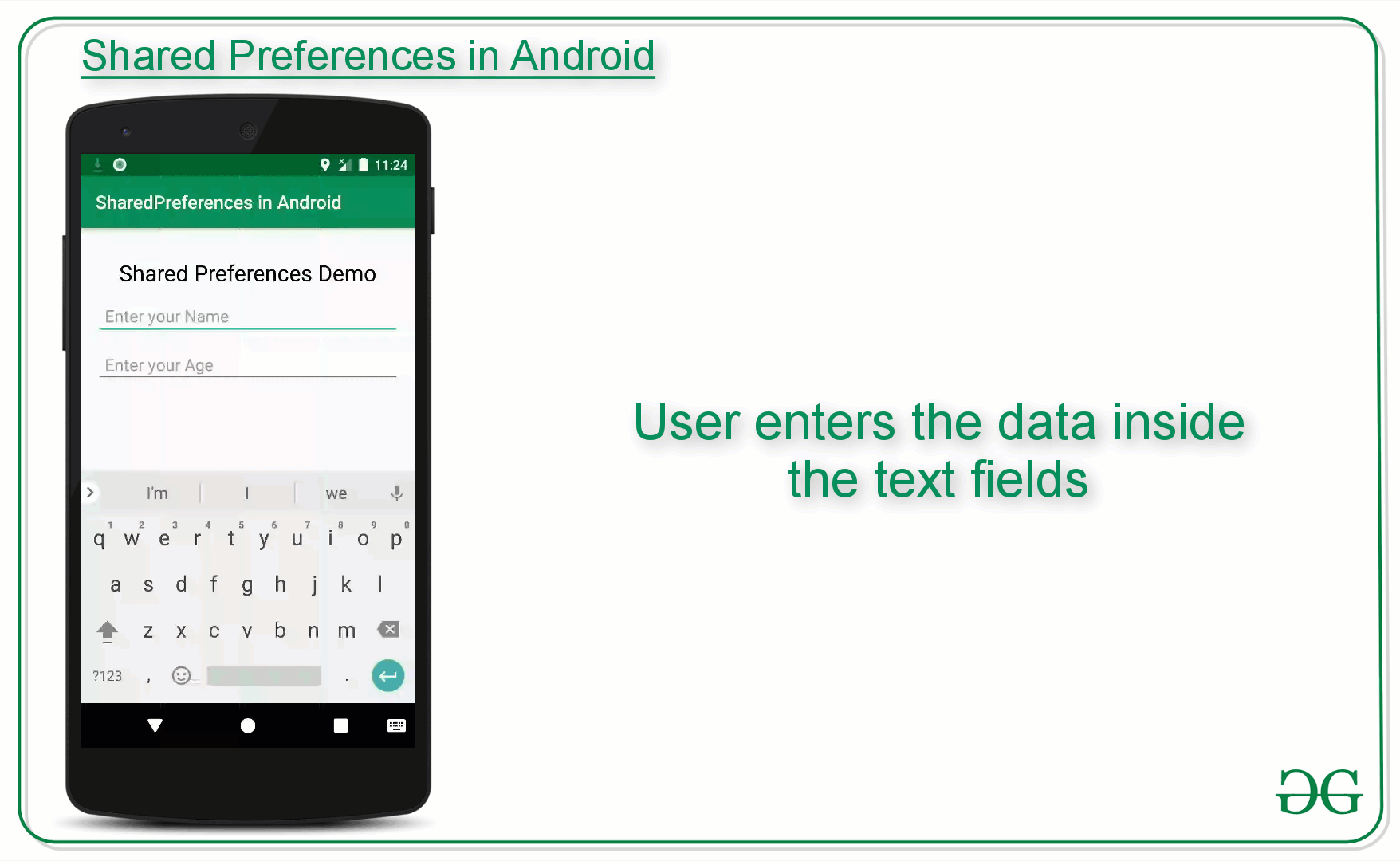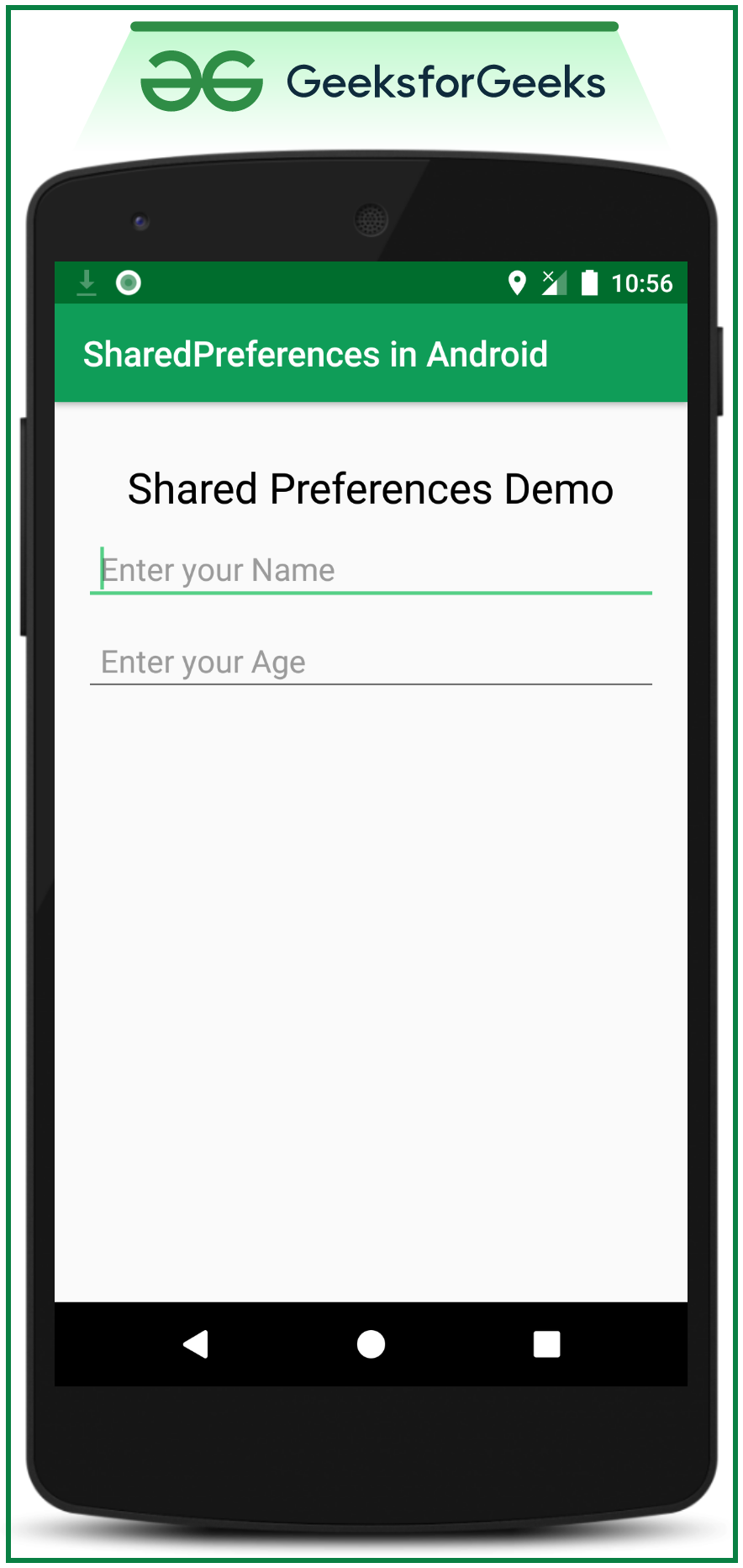Which Of The Following Is Not One Of The Ways That Preferences In Color Are Classified?
One of the most Interesting Data Storage options Android provides its users is Shared Preferences. Shared Preferences is the style in which one can store and call up small amounts of primitive information as key/value pairs to a file on the device storage such as String, int, float, Boolean that make upward your preferences in an XML file inside the app on the device storage. Shared Preferences can be thought of every bit a dictionary or a primal/value pair. For instance, you lot might have a central beingness "username" and for the value, you might store the user's username. And and so you could retrieve that past its fundamental (hither username). Y'all can have a simple shared preference API that you can use to store preferences and pull them back as and when needed. Shared Preferences grade provides APIs for reading, writing, and managing this information. A sample GIF is given below to go an idea most what nosotros are going to practise in this article. Note that we are going to implement this project using theCoffee linguistic communication.

Shared Preferences are suitable in dissimilar situations. For example, when the user's settings need to be saved or to shop data that tin be used in dissimilar activities within the app. As you know, onPause() will ever be called before your activity is placed in the background or destroyed, So for the data to be saved persistently, it's preferred to save information technology in onPause(), which could be restored in onCreate() of the activity. The data stored using shared preferences are kept private within the telescopic of the application. Even so, shared preferences are different from that activity'southward case land.
How is Shared Preferences different from Saved Example State?
| Shared Preferences | Saved Instance State |
|---|---|
| Persist Data across user sessions, fifty-fifty if the app is killed and restarted, or the device is rebooted | Preserves country data beyond activity instances in the same user session. |
| Data that should be remembered across sessions, such as the user's preferred settings or their game score. | Information that should not be remembered beyond sessions, such as the currently selected tab or current state of activity. |
| A common utilise is to store user preferences | A mutual use is to recreate the state after the device has been rotated |
How to Create Shared Preferences?
The starting time matter we need to do is to create one shared preferences file per app. So name it with the packet name of your app- unique and easy to associate with the app. When you lot want to go the values, call the getSharedPreferences() method. Shared Preferences provide modes of storing the data (private manner and public mode). It is for backward compatibility- apply merely MODE_PRIVATE to be secure.
public abstract SharedPreferences getSharedPreferences (String name, int style)
This method takes two arguments, the first being the name of the SharedPreference(SP) file and the other is the context mode that we want to store our file in.
MODE_PUBLIC volition make the file public which could exist attainable past other applications on the device
MODE_PRIVATE keeps the files private and secures the user's data.
MODE_APPEND is used while reading the information from the SP file.
Nested classes of Shared Preferences
- SharedPreferences.Editor: Interface used to write(edit) data in the SP file. Once editing has been done, ane must commit() or apply() the changes fabricated to the file.
- SharedPreferences.OnSharedPreferenceChangeListener(): Chosen when a shared preference is changed, added, or removed. This may exist chosen even if a preference is set to its existing value. This callback will be run on your main thread.
Post-obit are the methods of Shared Preferences
- contains(String fundamental): This method is used to check whether the preferences incorporate a preference.
- edit(): This method is used to create a new Editor for these preferences, through which yous can make modifications to the data in the preferences and atomically commit those changes back to the SharedPreferences object.
- getAll(): This method is used to remember all values from the preferences.
- getBoolean(String key, boolean defValue): This method is used to call up a boolean value from the preferences.
- getFloat(String key, bladder defValue): This method is used to retrieve a float value from the preferences.
- getInt(String key, int defValue): This method is used to think an int value from the preferences.
- getLong(String primal, long defValue): This method is used to remember a long value from the preferences.
- getString(String key, String defValue): This method is used to recollect a String value from the preferences.
- getStringSet(Cord key, Set defValues): This method is used to think a ready of String values from the preferences.
- registerOnSharedPreferencechangeListener(SharedPreferences.OnSharedPreferencechangeListener listener): This method is used to registers a callback to be invoked when a change happens to a preference.
- unregisterOnSharedPreferencechangeListener(SharedPreferences.OnSharedPreferencechangeListener listener): This method is used to unregisters a previous callback.
Following is sample byte lawmaking on how to write Information in Shared Preferences:
Java
SharedPreferences sharedPreferences = getSharedPreferences( "MySharedPref" ,MODE_PRIVATE);
SharedPreferences.Editor myEdit = sharedPreferences.edit();
myEdit.putString( "proper noun" , name.getText().toString());
myEdit.putInt( "historic period" , Integer.parseInt(age.getText().toString()));
myEdit.commit();
Following is the sample byte code on how to read Data in Shared Preferences:
Java
SharedPreferences sh = getSharedPreferences( "MySharedPref" , MODE_APPEND);
String s1 = sh.getString( "name" , "" );
int a = sh.getInt( "age" , 0 );
name.setText(s1);
age.setText(Cord.valueOf(a));
Case to Demonstrate the use of Shared Preferences in Android
Below is the modest demo for Shared Preferences. In this particular demo, at that place are two EditTexts, which save and retain the data entered earlier in them. This type of feature can be seen in applications with forms. Using Shared Preferences, the user volition not take to fill in details once again and again. Invoke the following code within the activity_main.xml file to implement the UI:
XML
<? xml version = "1.0" encoding = "utf-8" ?>
< RelativeLayout
android:layout_width = "match_parent"
android:layout_height = "match_parent"
tools:context = ".MainActivity"
tools:ignore = "HardcodedText" >
< TextView
android:id = "@+id/textview"
android:layout_width = "wrap_content"
android:layout_height = "wrap_content"
android:layout_centerHorizontal = "truthful"
android:layout_marginTop = "32dp"
android:text = "Shared Preferences Demo"
android:textColor = "@android:colour/black"
android:textSize = "24sp" />
< EditText
android:id = "@+id/edit1"
android:layout_width = "match_parent"
android:layout_height = "wrap_content"
android:layout_below = "@+id/textview"
android:layout_marginStart = "16dp"
android:layout_marginTop = "8dp"
android:layout_marginEnd = "16dp"
android:hint = "Enter your Name"
android:padding = "10dp" />
< EditText
android:id = "@+id/edit2"
android:layout_width = "match_parent"
android:layout_height = "wrap_content"
android:layout_below = "@+id/edit1"
android:layout_marginStart = "16dp"
android:layout_marginTop = "8dp"
android:layout_marginEnd = "16dp"
android:hint = "Enter your Historic period"
android:padding = "10dp"
android:inputType = "number" />
</ RelativeLayout >
Output UI:

Working with the MainActivity.java file to handle the two of the EditText to relieve the information entered past the user within the SharedPreferences. Beneath is the lawmaking for the MainActivity.java file. Comments are added inside the code to understand the code in more detail.
Java
import androidx.appcompat.app.AppCompatActivity;
import android.content.SharedPreferences;
import android.os.Parcel;
import android.widget.EditText;
public class MainActivity extends AppCompatActivity {
individual EditText name, age;
@Override
protected void onCreate(Bundle savedInstanceState) {
super .onCreate(savedInstanceState);
setContentView(R.layout.activity_main);
name = findViewById(R.id.edit1);
age = findViewById(R.id.edit2);
}
@Override
protected void onResume() {
super .onResume();
SharedPreferences sh = getSharedPreferences( "MySharedPref" , MODE_PRIVATE);
String s1 = sh.getString( "name" , "" );
int a = sh.getInt( "age" , 0 );
proper noun.setText(s1);
age.setText(String.valueOf(a));
}
@Override
protected void onPause() {
super .onPause();
SharedPreferences sharedPreferences = getSharedPreferences( "MySharedPref" , MODE_PRIVATE);
SharedPreferences.Editor myEdit = sharedPreferences.edit();
myEdit.putString( "name" , name.getText().toString());
myEdit.putInt( "age" , Integer.parseInt(age.getText().toString()));
myEdit.apply();
}
}
Output:
Reference: Shared Preferences | Android
Source: https://www.geeksforgeeks.org/shared-preferences-in-android-with-examples/
Posted by: salterqualis88.blogspot.com


0 Response to "Which Of The Following Is Not One Of The Ways That Preferences In Color Are Classified?"
Post a Comment